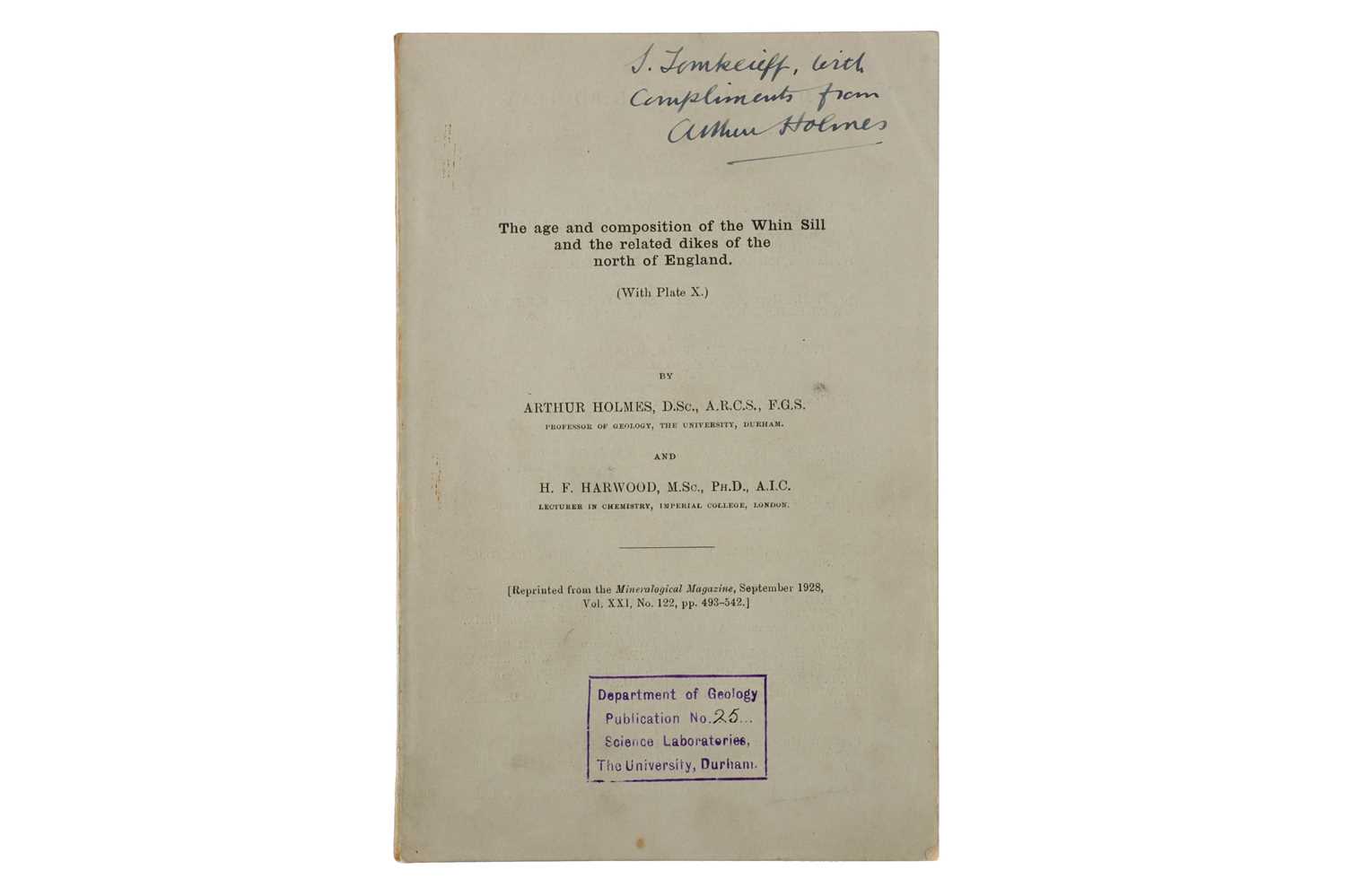24th May, 2023 12:00
Fine Instruments of Science, Medicine and Books
Holmes, Arthur, A Signed Copy of An Offprint
Titled 'The Age and Composition of the Whin Sill and related dikes of the north of England', by Arthur Holmes, D.Sc., A.R.C.S., F.G.S. professor of Geology, the University, Durham, and H. F. Harwood, M.Sc, PH.D., A.I.C. Lecturer in Chemistry, Imperial College, London, reprinted from the Mineralogical Magazine 1928 VolXXI No.122 pp. 493-542, signed in pen to the top 'S Tomkeiff, with Compliments from Arthur Holmes,
Arthur Holmes (14 January 1890 – 20 September 1965) was an English geologist who made significant contributions to the field of geochronology and the understanding of continental drift. Born on January 14, 1890, in Gateshead, England, Holmes was the son of a mechanical engineer. He graduated with a degree in physics from the University of London in 1910 and then studied geology at the Imperial College of Science and Technology.
Holmes is widely regarded as the pioneer of geochronology, which is the study of the age of rocks, minerals, and other geological features. In 1913, he published his first paper on radiometric dating, in which he proposed the use of isotopic dating methods to determine the age of rocks. This was a groundbreaking idea at the time, and it laid the foundation for the development of modern geochronology.
In 1911, Holmes began working on his doctoral thesis, which focused on the age of the Earth. He spent several years researching and analyzing the geological evidence, including the rate of radioactive decay, the distribution of elements in the Earth's crust, and the formation of the continents. In 1913, he published his findings in a book titled "The Age of the Earth," which became a landmark publication in the field of geology.
In "The Age of the Earth," Holmes argued that the Earth was much older than previously believed, with an estimated age of 4.6 billion years. He also proposed a model for the formation of the continents, which he called "continental drift." According to this model, the continents were once joined together in a single supercontinent called Pangaea, which then broke apart and drifted to their current positions.
Holmes' ideas on continental drift were not widely accepted at the time, and it was not until the 1960s that they were finally confirmed by the discovery of plate tectonics. Nevertheless, his work on the age of the Earth and geochronology had a significant impact on the field of geology, and he is still considered one of its most important pioneers.
In addition to his work on geochronology and continental drift, Holmes also made contributions to other areas of geology, including the study of volcanoes and the structure of the Earth's mantle. He was awarded numerous honors and awards for his work, including the Wollaston Medal from the Geological Society of London in 1943.
Arthur Holmes died on September 20, 1965, at the age of 75. His legacy as a pioneer of geochronology and a visionary geologist continues to inspire and influence geologists and scientists around the world.
Titled 'The Age and Composition of the Whin Sill and related dikes of the north of England', by Arthur Holmes, D.Sc., A.R.C.S., F.G.S. professor of Geology, the University, Durham, and H. F. Harwood, M.Sc, PH.D., A.I.C. Lecturer in Chemistry, Imperial College, London, reprinted from the Mineralogical Magazine 1928 VolXXI No.122 pp. 493-542, signed in pen to the top 'S Tomkeiff, with Compliments from Arthur Holmes,
Arthur Holmes (14 January 1890 – 20 September 1965) was an English geologist who made significant contributions to the field of geochronology and the understanding of continental drift. Born on January 14, 1890, in Gateshead, England, Holmes was the son of a mechanical engineer. He graduated with a degree in physics from the University of London in 1910 and then studied geology at the Imperial College of Science and Technology.
Holmes is widely regarded as the pioneer of geochronology, which is the study of the age of rocks, minerals, and other geological features. In 1913, he published his first paper on radiometric dating, in which he proposed the use of isotopic dating methods to determine the age of rocks. This was a groundbreaking idea at the time, and it laid the foundation for the development of modern geochronology.
In 1911, Holmes began working on his doctoral thesis, which focused on the age of the Earth. He spent several years researching and analyzing the geological evidence, including the rate of radioactive decay, the distribution of elements in the Earth's crust, and the formation of the continents. In 1913, he published his findings in a book titled "The Age of the Earth," which became a landmark publication in the field of geology.
In "The Age of the Earth," Holmes argued that the Earth was much older than previously believed, with an estimated age of 4.6 billion years. He also proposed a model for the formation of the continents, which he called "continental drift." According to this model, the continents were once joined together in a single supercontinent called Pangaea, which then broke apart and drifted to their current positions.
Holmes' ideas on continental drift were not widely accepted at the time, and it was not until the 1960s that they were finally confirmed by the discovery of plate tectonics. Nevertheless, his work on the age of the Earth and geochronology had a significant impact on the field of geology, and he is still considered one of its most important pioneers.
In addition to his work on geochronology and continental drift, Holmes also made contributions to other areas of geology, including the study of volcanoes and the structure of the Earth's mantle. He was awarded numerous honors and awards for his work, including the Wollaston Medal from the Geological Society of London in 1943.
Arthur Holmes died on September 20, 1965, at the age of 75. His legacy as a pioneer of geochronology and a visionary geologist continues to inspire and influence geologists and scientists around the world.
